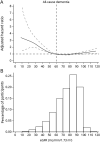Kidney Function, Kidney Function Decline, and the Risk of Dementia in Older Adults: A Registry-Based Study
- PMID: 33952656
- PMCID: PMC8253567
- DOI: 10.1212/WNL.0000000000012113
Kidney Function, Kidney Function Decline, and the Risk of Dementia in Older Adults: A Registry-Based Study
Abstract
Objective: Community-based reports regarding the association between the estimated glomerular filtration rate (eGFR) and dementia risk show conflicting results. The aim of this study is to investigate the links among kidney function, kidney function decline, and dementia incidence.
Methods: We analyzed the association of eGFR with the risk of dementia (defined as a new dementia diagnosis or initiation of dementia treatments) among 329,822 residents of Stockholm who accessed health care during 2006 to 2011, were ≥65 years of age, had no history of dementia, or underwent kidney replacement therapy. We also estimated the rate of eGFR decline among 205,622 residents with repeated eGFR measurements during the first year of observation and investigated its association with subsequent dementia risk.
Results: We detected 18,983 cases of dementia (5.8% of participants) over a median follow-up of 5 years. Dementia incidence rates were progressively higher with lower eGFR: from 6.56/1,000 person-years in those with eGFR of 90 to 104 mL/min to 30.28/1,000 person-years in those with eGFR <30 mL/min. After multivariable adjustment, lower eGFR was associated with a higher dementia risk (hazard ratio [HR] 1.71, 95% confidence interval [CI] 1.54-1.91 in eGFR 30-59 mL/min; HR 2.62, 95% CI 1.91-3.58 in eGFR <30 mL/min) compared with eGFR of 90 to 104 mL/min. A steeper decline in eGFR (decline >2 mL/min/1.73 m2/y) within 1 year was associated with higher dementia risk. Risk magnitudes were stronger for vascular dementia than for Alzheimer dementia. As many as 10% (95% CI 6%-14%) of dementia cases could be attributed to eGFR <60 mL/min/1.73 m2, a proportion higher than that attributed to other dementia risk factors such as cardiovascular disease and diabetes.
Conclusions: Both lower kidney function and steeper kidney function decline are associated with the development of dementia.
Copyright © 2021 The Author(s). Published by Wolters Kluwer Health, Inc. on behalf of the American Academy of Neurology.
Figures


Comment in
-
Reader Response: Kidney Function, Kidney Function Decline, and the Risk of Dementia in Older Adults.Neurology. 2021 Nov 16;97(20):966-967. doi: 10.1212/WNL.0000000000012875. Neurology. 2021. PMID: 34782415 No abstract available.
-
Author Response: Kidney Function, Kidney Function Decline, and the Risk of Dementia in Older Adults.Neurology. 2021 Nov 16;97(20):967. doi: 10.1212/WNL.0000000000012876. Neurology. 2021. PMID: 34782416 No abstract available.
References
-
- Kua EH, Ho E, Tan HH, Tsoi C, Thng C, Mahendran R. The natural history of dementia. Psychogeriatrics. 2014;14(13):196-201. - PubMed
-
- Prince M, Bryce R, Albanese E, Wimo A, Ribeiro W, Ferri CP. The global prevalence of dementia: a systematic review and metaanalysis. Alzheimers Dement. 2013;9(1):63-75.e62. - PubMed
-
- Clague F, Mercer SW, McLean G, Reynish E, Guthrie B. Comorbidity and polypharmacy in people with dementia: insights from a large, population-based cross-sectional analysis of primary care data. Age Ageing. 2017;46(1):33-39. - PubMed
-
- Garcia-Ptacek S, Farahmand B, Kareholt I, Religa D, Cuadrado ML, Eriksdotter M. Mortality risk after dementia diagnosis by dementia type and underlying factors: a cohort of 15,209 patients based on the Swedish Dementia Registry. J Alzheimers Dis. 2014;41(2):467-477. - PubMed
-
- National Institute for Health Care and Excellence. National Institute for Health and Care Excellence: Clinical Guidelines: Dementia: Assessment, Management and Support for People Living With Dementia and Their Carers. National Institute for Health and Care Excellence; 2018. - PubMed
LinkOut - more resources
Full Text Sources
Other Literature Sources
Research Materials
Miscellaneous
